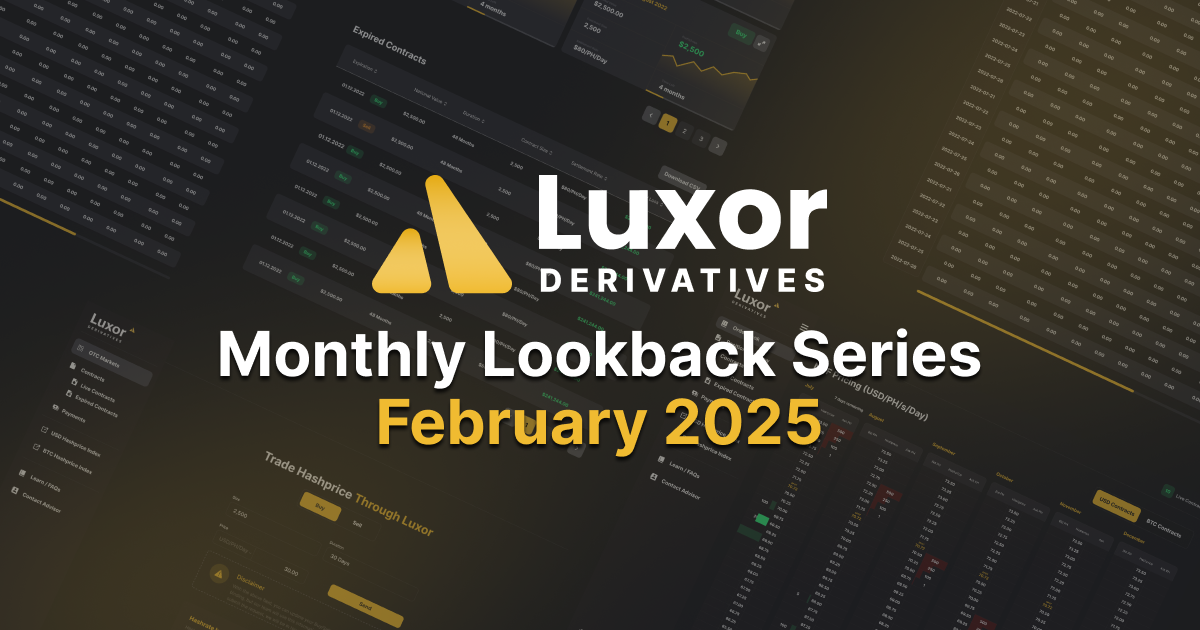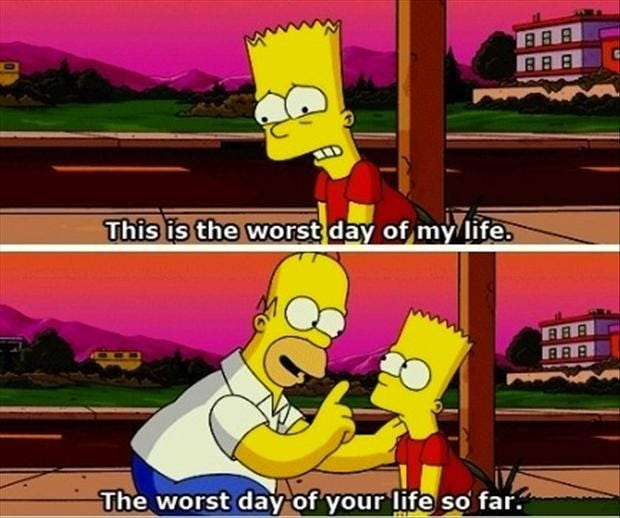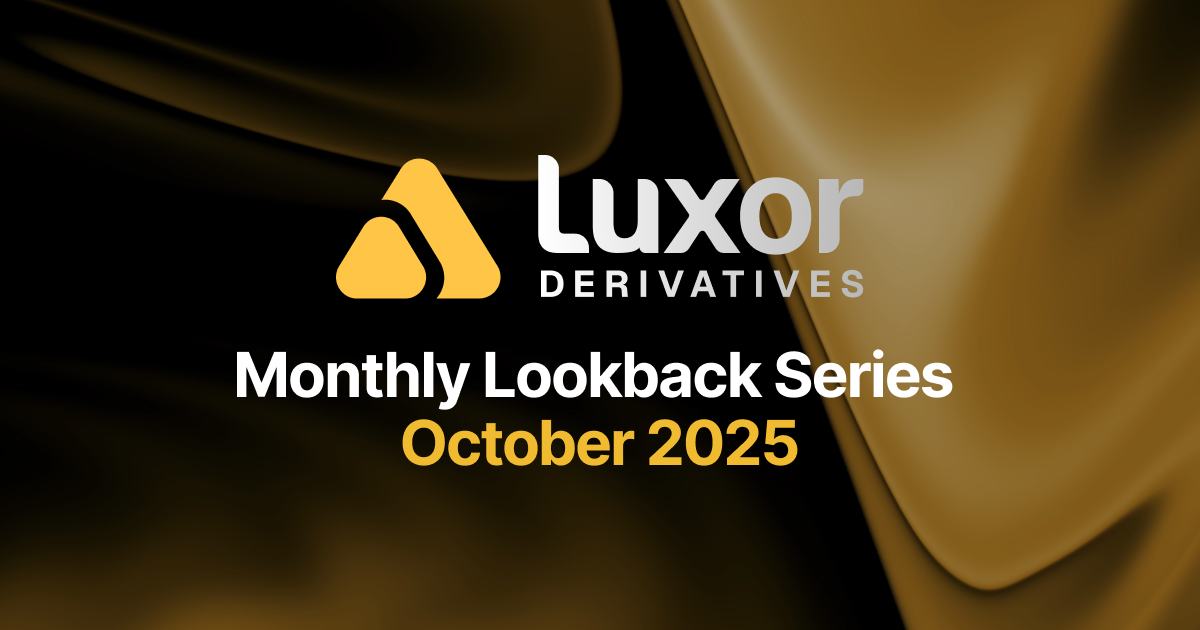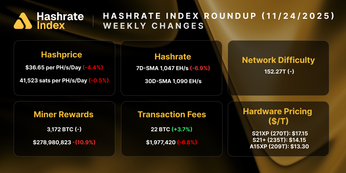
Hashrate Markets Lookback Series - February 2025
February 2025’s hashrate and hashprice trends, forward market participation, trading activity and contract performance.
Luxor’s Monthly Lookback Series is a deep dive into Bitcoin hashrate market activity. In this post, we cover February 2025’s hashrate and hashprice trends, forward market participation, trading activity and contract performance.
Summary
- February Fallout: Bitcoin mining conditions deteriorated in February as key market factors moved in the wrong direction. Bitcoin price dropped nearly 20%, transaction fees declined for a fourth consecutive month, and network difficulty reached new highs. As a result, both BTC and USD-denominated hashprice fell month-over-month, with USD hashprice dropping 6% on average.
- Mixed Market Outcomes: Hashrate market performance varied depending on timing and contract denomination. The optimal strategy was securing Bitcoin production 4–5 months in advance while hedging USD revenue 1–2 months ahead. The best time to buy February hashrate was 4–5 months prior, with USD-denominated contracts providing the highest returns.
- Expectations Calm Down: Bitcoin price expectations declined across March-July 2025 forward contracts, reflecting February’s dip. Implied network difficulty expectations dropped by 4-6%, suggesting a reassessment of future hashrate growth.
- Policy Uncertainty Ahead: Government policy is becoming a defining force in Bitcoin mining. Decisions around trade wars and strategic bitcoin reserves will be a major factor going forward.
February 2025 Spot Hashprice & Its Constituents
In February, Bitcoin mining markets took a negative turn. Compared to January, average Bitcoin price and transaction fees dropped 4.4% and 6.1% respectively, while network difficulty (hashrate) increased 1.7% to a new all time high. As a result, USD hashprice fell 6%, averaging $54.55 per PH/s/day.
During the month, the hashprice decline was even more pronounced. Starting at $59.94, hashprice fell over 21% to $47.27 – the lowest daily average since November 6 2024, immediately after the U.S. election.
The hashprice decline was largely driven by Bitcoin's 20% drop from a daily average $101,967 at the start of February to $81,968 at the end. Bitcoin fell below its post-election range of $90K–$105K towards the tail end of the month, as weak economic data and tariff concerns led investors to exit risky assets.
February’s fluctuations in network difficulty and hashrate were particularly interesting. The month began at 108.11T difficulty (~774 EH) after a -2.12% downward adjustment in late January. The downward network difficulty adjustment followed colder than expected weather in the U.S., which pushed up power prices and mining curtailment during the January 13 - 26 epoch.
But the weather event was temporary. Throughout the January 27 - February 8 epoch, block times increased as power prices came down and miners reduced curtailment. On February 9, a large 5.61% upward adjustment sent network difficulty up to 114.17T (~817 EH) – a new all time high.
During the February 9-23 period, block times slowed once again, prompting a -3.15% downward adjustment on February 24 to 110.57T (~791 EH). Despite this decline, the month ended with a net increase of 2.3% in network difficulty.
February’s cold weather, like January’s, disrupted U.S. power markets, impacting the February 24 difficulty adjustment. The ongoing inverse correlation between unprofitable mining hours in key U.S. power markets and difficulty adjustments highlights a structural dynamic in the mining ecosystem.
February 24’s negative adjustment surpassed January 27’s in scale, despite similar or higher average power prices in January. January’s cold snap caused brief extreme price spikes, inflating the average, while February saw a prolonged period of mildly uneconomic mining hours. Our analysis of spot hashprice and power prices suggests that downtime, rather than peak prices, proved to be the key factor reducing network difficulty in February.
Further, our analysis suggests that downtime hit hardest in Texas and the Southwest Power Pool (SPP), while PJM and MISO were less affected. Texas, which hosts an estimated 17% of global hashrate, magnified the impact.
The chart below illustrates the percentage point change in uneconomic mining hours (as a share of total hours in the difficulty epoch) from January to March 2025. It highlights a key pattern: weather-driven disruptions in hashrate-dense regions like Texas may significantly influence Bitcoin’s difficulty adjustments.
During the early part of the February 24 – March 8 epoch, network hashrate has remained stable at ~791 EH, about ~26 EH lower than February's first epoch. This drop persists despite fewer estimated unprofitable mining hours and reduced curtailment. The March 9 difficulty adjustment is currently projected to be 0.74%.
A likely cause is Bitcoin’s price decline. Hashrate Index Premium’s proprietary projections model suggests a ~26 EH reduction aligns with expected hashrate losses from economic curtailment following Bitcoin’s drop from $100K to $85K. The energy-adjusted hashprice for older-generation equipment (25-38 J/TH) has fallen from $0.08 per kWh at the start of the month to $0.061 per kWh. This means older generation operators with power prices in the $0.06-0.07 per kWh range are no longer profitable and may have to shut down.
Transaction fees continued to disappoint in February, falling for a fourth straight month. In bitcoin terms, fees collected per block averaged 0.043 BTC, a 6.07% drop from January. In USD terms, and adjusting for the monthly average Bitcoin price, average transaction fee collection per block in February was $4,129 — roughly in line with average fees observed in Q3 2024.
A single notable fee event occurred throughout the month, namely BRC-20 $MASK mints throughout February 22-24, which caused average fee collection per block to spike by over 130% from 0.046 BTC to 0.107 BTC. Although brief, this was a welcome surprise for operators online and hashing at the time.
After being cleared for the first time since April 2023 at the start of February, the Bitcoin network’s mempool size began building up again throughout the month. If this trend persists, it could signal growing network congestion, leading to longer transaction confirmation times and higher fees.
Low fees and alternating positive/negative difficulty adjustments had BTC denominated hashprice come and go in February. Starting at 0.00059 BTC per PH/s/day, hashprice fell to 0.00055 BTC per PH/s/day throughout the second and third week, gaining ground back by the end of the month to close at 0.00058 BTC per PH/s/day.
February 2025 Hashrate Market Activity
Our analysis of the February hashrate market focuses on two key points: how the February 2025 hashrate contract traded in previous months and how the forward curve shifted in February based on pricing for forward hashrate during the month.
The two tables below show the evolution of USD and BTC denominated Bitcoin hashrate forward markets throughout September 2024 - February 2025. Rows represent specific monthly contracts, while columns represent each trading month. Cell values indicate the average monthly mid-market price — except for the bold highlighted main diagonal — which shows actual spot hashprice settlement in each month.
This table summarizes both the trading history of the February 2025 contract (colored row) and the forward curve in February (colored column).
Note: all values shown in figures represent the midpoint of the best bid and ask on Luxor's Non-Deliverable Hashprice Forward market.
The table below shows the type of market participants on the buy and sell side of Luxor’s deliverable (DF) and non-deliverable hashrate forward (NDF) market. In February, lenders were active on the buy side of the DF market, while public and private miners used the contract to sell forward, receive financing, and expand their fleet.
Since the DF involves upfront payment, it tends to trade at a discount to the NDF to compensate the buyer for the inherent credit risk. We see the discount of DF’s relative to NDF’s as the interest rate in hashrate-based lending markets. Buyers and sellers of the DF with upfront payment can use the NDF to lock-in a fixed yield or cost of capital instead of having exposure to the uncertain and variable returns of hashprice. This strategy was used by lenders (Buy the DF & Sell the NDF) to earn a return and by miners (Sell the DF & Buy the NDF) to obtain non-dilutive financing. In February 2025, that yield or cost of capital was in the 8-13% annualized range.
How February 2025 Hashrate Traded
February's forward hashrate market mirrored recent months’ trends but differed due to a Bitcoin price dip in the spot market. USD and BTC denominated hashrate markets therefore saw distinct outcomes.
In USD markets, February hashprice settled higher than in September-November 2024 but lower than in December 2024 and January 2025. For September-November trades, long positions won, while hedgers incurred losses. This trend turned in favour of short-duration hedgers (1-2 months out) as Bitcoin price declined.
In BTC markets, February hashprice settled below September-November 2024 levels and remained flat through December 2024 and January 2025. Hedgers profited by locking in a higher hashprice and total Bitcoin production, while long positions incurred losses.
The table below summarizes how a 1 EH mining operation’s USD revenues would have performed, had it sold February 2025 hashrate forward versus mining spot during the month:
In USD terms, it was a mixed bag on whether to be hedged and/or buy hashrate from the forward market for February. Buyers of the February 2025 USD contract in September saw the highest returns, while sellers generally lost — except those who hedged in December or January. Selling in December earned an 8% premium over spot mining, but overall, hedgers saw 4-26% lower returns than spot miners.
The table below summarizes how a 1 EH mining operation’s total bitcoin production would have performed, had it sold February 2025 hashrate forward versus mining spot during the month:
In BTC terms, hedging was the best strategy for Bitcoin miners. If a miner had fully hedged at the average mid-market price in September or October, they could have mined 12% and 11% more bitcoin than those miners which mined at spot prices through February. Those who fully hedged in November, December, and January produced 3%, 1%, and 1% more bitcoin versus spot miners. In BTC terms, it was best to sell early, or conversely, buy late.
Overall, the optimal strategy for miners in February would have been to lock-in Bitcoin production early (4-5 months out), followed by hedging USD revenue later (1-2 months out).
Most public mining companies did not hedge Bitcoin production in February 2025. The chart below illustrates a hypothetical scenario of how public miners' February Bitcoin production would have differed if they had fully hedged their production back in September:
Note: this figure is strictly for demonstration purposes and based on the simplifying assumption of multiplying actual production figures by the percentage difference between hashrate forward contracts’ locked-in hashprice versus spot hashprice; it excludes fees and bid/ask spreads associated with entering into hashrate forward contracts.
A second caveat: although selling forward proved to be favorable in this instance, it is critical to recognize that hedging is typically a cost of business rather than a revenue generation method. Hedgers willingly pay a price to buy certainty and obtain more predictable cash flows, which increases valuation, reduces cost of capital, and ultimately attracts investments.
How Future Hashrate Traded in February 2025
The two tables below summarize the evolution of Bitcoin hashrate forward markets during February 2025, for the subsequent five months from March 2025 through July 2025. Rows represent specific monthly hashrate contracts, while columns represent specific trading days. Cell values indicate the average daily mid-market price, except for spot prices.
During February trading, the USD curve exhibited mixed trading patterns: starting off in backwardation, contracts went into contango for the front month during the second and third weeks and returned to backwardation by the end of February. So far in March, the front months of the USD contracts are trading in contango. In contrast, the BTC curve traded mostly in backwardation throughout February, which has continued into March. Expectations for USD denominated contracts fell over the month, whereas expectations for BTC denominated forward hashrate contract pricing rose.
Given this information, we can use the two contracts (by dividing USD contract values with BTC contract values) to back out implied Bitcoin price expectations expressed by the market. Similar to USD hashprice, implied future Bitcoin price expectations fell throughout the month.
If we make an assumption around transaction fees, we can calculate the changes in implied difficulty and network hashrate expectations expressed by the forwards market. In the tables below, we assume a 0.05 BTC and 0.08 BTC per block transaction fee collection on February 3rd and March 3rd:
Note: figures assume 0.05 BTC and 0.08 BTC per block transaction fee collection on February 3rd and March 3rd, 2025.
Based on this simplified analysis, we estimate that future hashrate expectations decreased during the month of February, dropping in the 4-6% range for the March - July contracts.
Looking Ahead and Concluding Thoughts
Bitcoin mining has always been shaped by market forces such as energy costs, hardware efficiency, and price volatility. However, in 2025, government policy is emerging as a critical factor influencing the industry’s trajectory. More than ever, government decisions may shape profitability, network growth, and overall market confidence in the coming months.
In February, U.S. Customs and Border Protection (CBP) intensified its crackdown on Bitcoin mining hardware imports. Initially targeting Bitmain’s Antminer models, the restrictions quickly expanded to include equipment from other major manufacturers like MicroBT and Canaan. With detentions spreading across multiple entry points, U.S.-based mining firms faced operational disruptions and financial strain. While it remains unclear whether these detentions will persist, they have already increased costs and delayed hardware deployments, directly impacting miners’ competitiveness and profitability.
Adding to these challenges, the Trump administration’s new tariffs — effective March 2025 — introduce a 25% levy on imports from Canada and Mexico and a 20% levy on Chinese goods. These tariffs may affect the Bitcoin mining sector, as much of the global hardware supply originates in Asia, and a sizable share of North American hashrate production is concentrated along the U.S.-Canada border. The policy has already sparked political tensions, with Ontario Premier Doug Ford threatening to impose a 25% surcharge on electricity exports to Michigan, New York, and Minnesota, or cut them off entirely, if the U.S. escalates tariffs on Canadian goods and energy. These potential disruptions increase uncertainty for local mining operators, as the potential for power cuts and curtailment looms.
Beyond trade policy, the emergence of strategic Bitcoin reserves (SBRs) is gaining traction in U.S. political discussions. While the implications remain unclear, state-driven Bitcoin accumulation could introduce new demand dynamics, influencing price trends and mining economics.
With network difficulty growth slowing in both spot and forward markets, low transaction fees, and macroeconomic uncertainty, Bitcoin mining markets may be in for a ride before closing off Q1. To navigate these challenges, miners are using hashrate markets to reduce revenue risk, finance operations and boost mining rewards.
Looking forward, Luxor’s Hashrate Forward Market is pricing in an average hashprice of $51.94 (0.00056) BTC per PH/s/Day over the next six months. Sellers can currently secure this hashprice while buyers have the opportunity to lock in the same hashcost through to August 2025.
If you’d like to learn more about Luxor’s Bitcoin mining derivatives, please reach out to [email protected] or visit https://www.luxor.tech/derivatives.
Disclaimer
This content is for informational purposes only, you should not construe any such information or other material as legal, investment, financial, or other advice. Nothing contained in our content constitutes a solicitation, recommendation, endorsement, or offer by Luxor or any of Luxor’s employees to buy or sell any derivatives or other financial instruments in this or in any other jurisdiction in which such solicitation or offer would be unlawful under the derivatives laws of such jurisdiction.
There are risks associated with trading derivatives. Trading in derivatives involves risk of loss, loss of principal is possible.
Hashrate Index Newsletter
Join the newsletter to receive the latest updates in your inbox.








